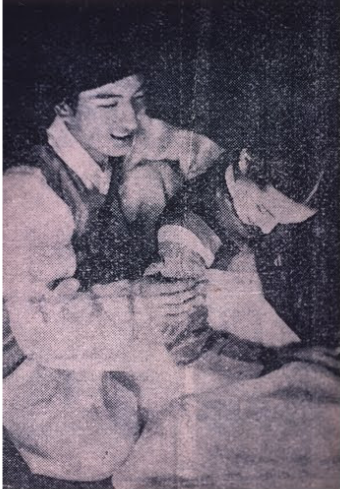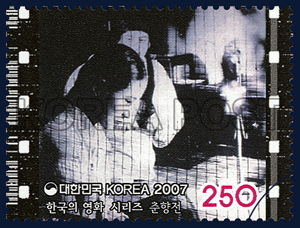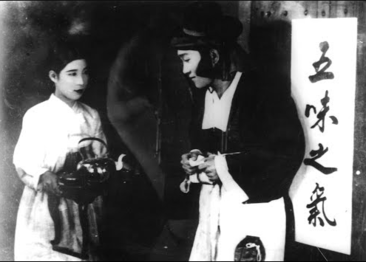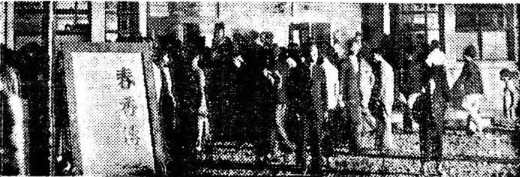Chunhyangjeon (lost Korean sound film; 1935): Difference between revisions
mNo edit summary |
No edit summary |
||
| (2 intermediate revisions by 2 users not shown) | |||
| Line 5: | Line 5: | ||
|status=<span style="color:red;">'''Lost'''</span> | |status=<span style="color:red;">'''Lost'''</span> | ||
}} | }} | ||
'''''Chunhyangjeon''''' (춘향전; ''The Story of Chun-hyang'') was the first Korean-made sound film released in 1935. The film is an adaptation of the 18th century Korean novel ''Chunhyangjeon''. During the sound film period, many theatres in Korea competed to screen foreign sound films. However, sound films had not yet been produced in Korea at that time. Accordingly, the release of ''Chunhyangjeon'' was a wish come true for many Korean film lovers. The film is more meaningful as the sound technologies were all domestically developed.<ref>[https://artsandculture.google.com/exhibit/korea%E2%80%99s-classical-%E2%80%9Cchunhyangjeon%E2%80%9D-the-story-of-chunhyang-made-into-film/wQwYHVsV Google Arts & Culture article on ''Chunhyangjeon''.] Retrieved 24 Mar '20</ref> | |||
===Summary=== | ===Summary=== | ||
Chun- | Chun-hyang, the daughter of a ''gisaeng'' from [https://en.m.wikipedia.org/wiki/Namwon Namwon], and Yi Mong-ryong are engaged. When Mong-ryong goes up to Hanseong with his father, the newly appointed magistrate, attempts to take Chun-hyang. Chun-hyang rejects his pleas for her to come to serve him, and he throws her in jail. Meanwhile, Mong-ryong becomes an undercover detective after placing first on his national exam and goes to Namwon to arrest Byeon Hak-do and rescue Chun-hyang. | ||
===Reception=== | ===Reception=== | ||
The film | The film has been criticized for its technical errors and the cast’s lack of acting skills. The sound technique was reportedly poor because no one knew how to use the machine; they had to resort to post-production dubbing to record the sound. Unlike silent films, they needed advanced equipment such as sound-proof cameras, silent lights, and a studio to control external noises. Despite these technical shortcomings, people were amazed by the live video with sound. ''Chunhyangjeon'' became an instant hit and stayed in the theatres for an extended period of time<ref>[https://eng.koreafilm.or.kr/kmdb/trivia/funfacts/BC_0000005063 Korean Film Archive fun facts page on ''Chunhyangjeon''.] Retrieved 24 Mar '20</ref> as Korean audiences appreciated hearing their own language in the cinema. | ||
===Availability=== | ===Availability=== | ||
The film is known to be lost and is more likely simply one of the many Korean films that were lost as a side effect of war. The only remaining snippet of footage is found in another film, titled ''Spring of the Penisula'' (반도의 봄). In the film, there is a very long scene that depicts Korean filmmakers shooting ''Chunhyangjeon''. Alongside that footage and a couple of stills from the film, ''Chunhyangjeon'' is lost to this day. | |||
===Gallery=== | ===Gallery=== | ||
| Line 20: | Line 20: | ||
|service1 =youtube | |service1 =youtube | ||
|id1 =vWtMAV2yS-g | |id1 =vWtMAV2yS-g | ||
|description1 =Excerpt from ''Spring of | |description1 =Excerpt from ''Spring of the Peninsula''; the ''Chunhyangjeon'' shooting scene. | ||
}} | }} | ||
<gallery mode=packed heights=175px> | <gallery mode=packed heights=175px> | ||
Chunhyangjeon_film_stamp_300.jpg|''Chunhyangjeon'' | Chunhyangjeon_film_stamp_300.jpg|A ''Chunhyangjeon''-themed stamp from the Korean Film Archive. | ||
Chqn.PNG| | Chqn.PNG|A still from the Korean Film Archive. | ||
Chqn2.PNG|Chosun Ilbo Article (from Apil 10th, 1935). | Chqn2.PNG|Chosun Ilbo Article (from Apil 10th, 1935). | ||
Chqn3.PNG|People lined up in front of a theatre to see ''Chunhyangjeon''. Photo printed with an ad on the October 9th, 1935 publication of ''Donga Ilbo''. | Chqn3.PNG|People lined up in front of a theatre to see ''Chunhyangjeon''. Photo printed with an ad on the October 9th, 1935 publication of ''Donga Ilbo''. | ||
| Line 37: | Line 37: | ||
[[Category:Historic]] | [[Category:Historic]] | ||
[[Category:Completely lost media]] | [[Category:Completely lost media]] | ||
Latest revision as of 00:47, 31 October 2023
Chunhyangjeon (춘향전; The Story of Chun-hyang) was the first Korean-made sound film released in 1935. The film is an adaptation of the 18th century Korean novel Chunhyangjeon. During the sound film period, many theatres in Korea competed to screen foreign sound films. However, sound films had not yet been produced in Korea at that time. Accordingly, the release of Chunhyangjeon was a wish come true for many Korean film lovers. The film is more meaningful as the sound technologies were all domestically developed.[1]
Summary
Chun-hyang, the daughter of a gisaeng from Namwon, and Yi Mong-ryong are engaged. When Mong-ryong goes up to Hanseong with his father, the newly appointed magistrate, attempts to take Chun-hyang. Chun-hyang rejects his pleas for her to come to serve him, and he throws her in jail. Meanwhile, Mong-ryong becomes an undercover detective after placing first on his national exam and goes to Namwon to arrest Byeon Hak-do and rescue Chun-hyang.
Reception
The film has been criticized for its technical errors and the cast’s lack of acting skills. The sound technique was reportedly poor because no one knew how to use the machine; they had to resort to post-production dubbing to record the sound. Unlike silent films, they needed advanced equipment such as sound-proof cameras, silent lights, and a studio to control external noises. Despite these technical shortcomings, people were amazed by the live video with sound. Chunhyangjeon became an instant hit and stayed in the theatres for an extended period of time[2] as Korean audiences appreciated hearing their own language in the cinema.
Availability
The film is known to be lost and is more likely simply one of the many Korean films that were lost as a side effect of war. The only remaining snippet of footage is found in another film, titled Spring of the Penisula (반도의 봄). In the film, there is a very long scene that depicts Korean filmmakers shooting Chunhyangjeon. Alongside that footage and a couple of stills from the film, Chunhyangjeon is lost to this day.
Gallery
External Link
- IMDb page on Chunhyangjeon. Retrieved 24 Mar '20
References
- ↑ Google Arts & Culture article on Chunhyangjeon. Retrieved 24 Mar '20
- ↑ Korean Film Archive fun facts page on Chunhyangjeon. Retrieved 24 Mar '20




